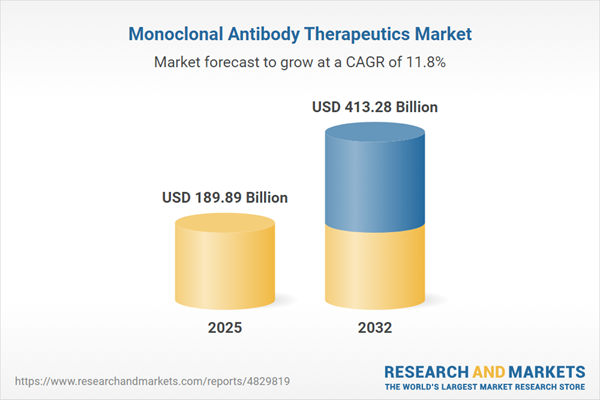Speak directly to the analyst to clarify any post sales queries you may have.
Monoclonal antibody therapeutics are transforming care delivery by providing tailored, targeted interventions across major disease categories. Senior decision-makers prioritize these therapies to enhance clinical precision, strengthen operational agility, and support adaptable growth.
Market Snapshot: Monoclonal Antibody Therapeutics Market Overview
The monoclonal antibody therapeutics market stands at USD 169.87 billion in 2024 and is expected to reach USD 189.89 billion by 2025, representing a compound annual growth rate of 11.75%. Increasing adoption of biologic therapies and favorable regulatory environments are driving this trajectory. Strategic investments help industry leaders address unmet patient needs across oncology, autoimmune, neurological, and infectious diseases. Companies seek to boost operational efficiency and forge strong partnerships, ensuring resilience and competitiveness amid evolving patient and provider requirements.
Scope & Segmentation of the Monoclonal Antibody Therapeutics Market
Comprehensive segmentation of the monoclonal antibody therapeutics market provides actionable insight for executive teams, enabling refined capital allocation and targeted strategies. Each segment reveals distinct opportunities for advancing clinical value and optimizing commercialization.
- Indication: Oncology, autoimmune, neurological, infectious, and cardiovascular disorders present key focus areas supporting specialized care through targeted therapy approaches.
- Antibody Type: Chimeric, humanized, fully human, and murine antibodies each demand unique development, regulatory pathways, and risk management, informing critical investment decisions.
- Molecular Target: Leveraging biomarkers such as CD20, EGFR, HER2, and TNF alpha facilitates the development of precision medicines and long-term product pipelines responsive to emerging scientific trends.
- Production Technology: Hybridoma, recombinant DNA, and transgenic technologies influence scalability, cost management, and supply chain resilience, underpinning strategic sourcing and manufacturing choices.
- Route of Administration: Intravenous, subcutaneous, and intramuscular delivery methods support patient-centric models and align with diverse healthcare infrastructure requirements.
- Distribution Channel: Hospitals, retail, specialty centers, and online platforms play distinct roles in expanding access and meeting varied patient needs.
- End User: Key adoption points include hospitals, clinics, laboratories, and specialized facilities, each influencing uptake, market penetration, and overall commercial strategy.
- Therapy Type: Both monotherapies and combination regimens enable flexibility in clinical and commercial strategies, broadening therapeutic options.
- Regions: The Americas, Europe, Middle East & Africa, and Asia-Pacific introduce diverse payer landscapes, policy frameworks, and innovation speeds, shaping regional competitive advantages.
- Companies: Established industry participants such as F. Hoffmann-La Roche Ltd, AbbVie Inc., Merck & Co., Bristol-Myers Squibb, Johnson & Johnson, Amgen, Novartis, Pfizer, AstraZeneca, and Sanofi drive advancement and set operational benchmarks.
Key Takeaways for Senior Decision-Makers
- Pursuing a patient-centric approach enables organizations to integrate monoclonal antibody therapeutics within broader disease management programs and align with value-based healthcare priorities.
- Applying digital solutions, including artificial intelligence, accelerates research timelines, enhances oversight for clinical operations, and supports data-driven portfolio management for strategic agility.
- Maintaining organizational resilience and adaptable compliance systems positions companies to keep pace with dynamic global regulations and industry evolutions.
- A competitive landscape shaped by biosimilar entry compels the adoption of innovative pricing models, payer collaborations, and new contractual structures to maintain market positioning.
- Strategic collaborations with academic and research institutes foster pipeline innovation, amplify access to scientific advancements, and contribute to long-term sustainability.
Tariff Impact: United States Reforms in 2025
- Recent United States tariff reforms have led to increased production and operational expenditures, driving companies to reexamine manufacturing and supply strategies for improved stability.
- Supplier diversification and targeted outsourcing are critical levers to enhance supply chain robustness and navigate ongoing trade challenges.
- Smaller biotech organizations focus on localizing supply sources to proactively manage emerging tariff uncertainties.
- Payers and providers are refining reimbursement frameworks to balance cost containment and continued treatment access for patients.
Methodology & Data Sources
This market research incorporates firsthand perspectives from biopharmaceutical executives, along with an in-depth review of industry analyses, regulatory submissions, and international patent data. The methodology ensures findings address the operational and strategic needs of senior leadership.
Why This Report Matters
- Enables executive teams to anticipate sector shifts, optimize capital distribution, and shape strategies through robust market segmentation and competitor insights.
- Provides actionable recommendations and timely guidance, supporting resilience and operational flexibility amid rapid regulatory and technological changes.
- Delivers focused intelligence for strategic decision-making within the evolving biologics landscape, supporting sustainable growth.
Conclusion
Monoclonal antibody therapeutics continue to shape patient outcomes and foster collaborative growth. Adaptability and a strategic approach to partnerships drive success in a market advancing through innovation and regulatory evolution.
Additional Product Information:
- Purchase of this report includes 1 year online access with quarterly updates.
- This report can be updated on request. Please contact our Customer Experience team using the Ask a Question widget on our website.
Table of Contents
3. Executive Summary
4. Market Overview
7. Cumulative Impact of Artificial Intelligence 2025
List of Figures
Companies Mentioned
The companies profiled in this Monoclonal Antibody Therapeutics market report include:- F. Hoffmann-La Roche Ltd
- AbbVie Inc.
- Merck & Co., Inc.
- Bristol-Myers Squibb Company
- Johnson & Johnson
- Amgen Inc.
- Novartis AG
- Pfizer Inc.
- AstraZeneca PLC
- Sanofi S.A.
Table Information
| Report Attribute | Details |
|---|---|
| No. of Pages | 189 |
| Published | November 2025 |
| Forecast Period | 2025 - 2032 |
| Estimated Market Value ( USD | $ 189.89 Billion |
| Forecasted Market Value ( USD | $ 413.28 Billion |
| Compound Annual Growth Rate | 11.7% |
| Regions Covered | Global |
| No. of Companies Mentioned | 11 |









